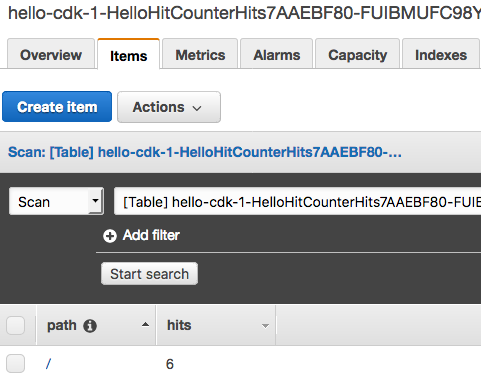Issue a few test requests #
Let’s issue a few requests and see if our hit counter works. You can also use your web browser to do that:
curl https://xxxxxxxxxx.execute-api.us-east-1.amazonaws.com/prod/
curl https://xxxxxxxxxx.execute-api.us-east-1.amazonaws.com/prod/
curl https://xxxxxxxxxx.execute-api.us-east-1.amazonaws.com/prod/hello
curl https://xxxxxxxxxx.execute-api.us-east-1.amazonaws.com/prod/hello/world
curl https://xxxxxxxxxx.execute-api.us-east-1.amazonaws.com/prod/hello/world
Open DynamoDB console #
-
Go to the DynamoDB console.
-
Make sure you are in the region where you created the table.
-
Select
Tablesin the navigation pane and select the table that starts withcdkworkshop-HelloHitCounterHits. -
Open the table and select “Items”.
-
You should see how many hits you got for each path.

-
Try hitting a new path and refresh the Items view. You should see a new item with a
hitscount of one.
Good job! #
The cool thing about our HitCounter is that it’s quite useful. It basically
allows anyone to “attach” it to any Lambda function that serves as an API
Gateway proxy backend and it will log hits to this API.
Since our hit counter is a simple Python class, you could package it into a
pip module and publish it to PyPi, which is the
Python package manager. Then, anyone could pip install it and add it to
their CDK apps.
In the next chapter we consume a construct library published to pip, which enables us to view the contents of our hit counter table from any browser.